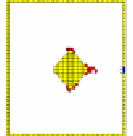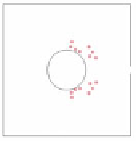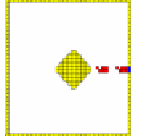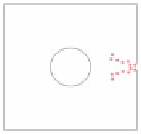Information Technology Reference
In-Depth Information
The people will change
their moving directions
once their escaping path
isn't kept back by the
obstacle
The people will change
their moving directions
once their escaping path
isn't kept back by the
obstacle
The people will avoid the
obstacle only when they
are near to the obstacles.
We can hardly see the
congestion near the exit
There is significant
congestion near the exit
There is significant
congestion near the exit
Fig. 3.
(
Continued
)
It is obvious that everything is treated as a small grid in the Cellular Automata
Model, which limits the true extent of its simulation. It can't represent the ideal avoid-
ing obstacle path. However, it is of the most efficiency among the three models.
Compared with the Cellular Automata Model, the Social Force Model can repre-
sent the process of avoiding the obstacle and the congestion near the exit better. But
the calculating efficiency is very low.
Our model has nearly the same accuracy with the Social Force Model. In the aspect
of the congestion near the exit our model seems does better. What's more, our effi-
ciency is less than half of the Social Force Model (in the same calculating conditions,
the Social Force Model needs to calculate 2089 times, while our model needs 1018
times).
Then we can get the data comparison as Table 1:
Table 1.
The data comparison among three models
Congestion near the
exit
The path avoiding
the obstacle
Times need to
calculate
The Model
Social Force
Model
Avoid once the
person finds it
It can reflect
2089 times
Avoids along the
edge of the
obstacle
Cellular
Automata Model
It can hardly
reflect
48 times
Avoid once the
person finds it
Our Model
It can reflect
1076 times






















Search WWH ::

Custom Search